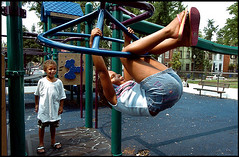I can't believe he said that -- another example of what I call "Blaming the Building"
 Urban Blight according to the District Government.
Urban Blight according to the District Government. (Caption: Photo by Katherine Frey, The Washington Post. New York Avenue Park, the library, playground, basketball court and baseball diamond may become low cost housing for those displaced at Sursum Corda caption: Camden "Tony" Smith, 5, left, watches his sister Breanna "B.B." Smith, 7, swing on the playground at New York Ave. park. The park may be replaced by low-income housing.)
In "Residents Decry Plan To Replace NW Park: Site Would Get Mixed Housing," today's Post reports on a city government proposal to convert a park to housing, to include affordable housing.
This is part of what I think of as what appears to be a concerted approach to convert neighborhood-serving (or potentially neighborhood-serving) public assets such as schools, parks, community centers and libraries to non-neighborhood-serving* use.
Interestingly enough, the City Government appears to be trying to execute this by pitting different groups of community activists against each other, making it difficult to create coalitions to oppose such proposals.
In this case, the proposal has the potential to pit affordable housing activists in favor of maintaining and expanding the stock of lower-income housing against neighborhood residents equally concerned with maintaining community-serving public assets such as parks.
Getting back to the infuriating quote:
"The irony is, if you go there in the day or the evenings, there are lots of problems with vagrants in the park, anyway," said Michael Downie, who is overseeing the New Communities initiative for the D.C. Office of Planning. "Our perception is the only people using the park are people who walk their dogs and vagrants. There's some use of the courts and fields by Little League teams, but it's not a very programmed, active space."
___________
Ironically, Mr. Dowie was the "revitalization planner and project manager" for the Columbia Heights Public Realm Framework.
So the solution is to get rid of the public space, rather than to address the factors necessary to make it a successful public space?
Aargh!
While this isn't a building, it's another example of what I call "Blaming the Building," of focusing on getting rid of the use, rather than improving the space. "Blaming the building" is usually applied to buildings experiencing neglect. Rather than address the neglect (or disinvestment) and improve the building, people are led to believe the solution is demolition. Usually this is a short-sighted approach that replaces a neglected building with an empty lot that becomes a cesspool of trash and a negative space that contributes to various forms of disorder. The solution is improving the property, not making it worse.
It's not any different from what Jane Jacobs wrote about 40 years ago in Death and Life of Great American Cities.
She wrote that oftentimes the justification used for tearing down neighborhoods in favor of "urban renewal" was to "get rid of the rats."
Destroying a neighborhood doesn't get rid of rats, it just provides new domiciles for the rats.
Destroying a park isn't the best solution for improving the public realm.
There are many resources available to the Office of Planning in this area, from the "Urban Parks" initiative of the American Planning Association, and the many items available on the Project for Public Spaces or the Trust for Public Lands Website. And OP has a number of staffers fully aware of pro-public realm planning and revitalization.
David Barth, of the urban design firm Glatting Jackson, has come up with a great approach linking "new urbanism-pro-urbanism" with the City Beautiful movement in what he calls “The City Revival Model: Redesigning the Public Realm." He gave this presentation at the APA meeting in DC last year, and I see that he is giving it again at the National Recreation and Parks Association Congress, October 20, 2005, San Antonio, Texas.
Maybe the city government can send Mr. Downie to this meeting as a refresher. (P.S. the Columbia Heights Public Realm Framework is pretty good!)
_______
* Increasingly, I believe that another example of non-neighborhood serving uses are charter schools. The buildings no longer serve as centers for neighborhood and community development in a localized fashion, and since the schools don't primarily serve students from the immediate neighborhood, they are no longer "walkable" schools, and contribute upwards of 500 car trips/day. Multiply this for each charter school and you see an incredible amount of induced driving trips...



0 Comments:
Post a Comment
<< Home